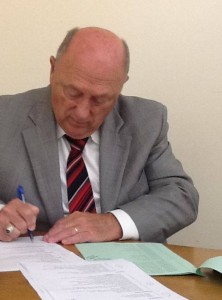Litigation Themes

R. Peter Decato – Firm Director, Decato Law Office in Lebanon, NH. Click to read Peter’s history.
LITIGATION THEMES – By Peter Decato, Esquire
What Trial Attorneys Do…
Every attorney who has ever been serious about trying cases in court will understand the need to develop a theory of the case. To be successful, an attorney needs to present a position that justifies a verdict. Once this theory of the case is in an attorney’s mind, it is the engine that drives the case.
It directs discovery efforts (efforts to get information from the opponent and others) and it directs how the trial itself is conducted. Entire cases are prepared using the theory
of the case.
The theory of the case is sometimes condensed into a slug line. Slug lines are generally pithy statements – sometimes memorable in the way they are crafted – that sum up the theory of
the case. I think I can give you a clear example.
Years ago former Vermont Governor – then Attorney Thomas Salmon was representing a plaintiff in a breach of contract case. The defendant was from New Jersey and the plaintiff was from Vermont. Throughout the trial, Governor Salmon kept pounding his theory of the case – that the defendant had breached the contract. In his closing,
Governor Salmon had a couple of slug lines. He said something like: “Same old story. Someone gets something and they don’t want to pay for it.” He then said: “I don’t know much about New Jersey, but I do know about Vermont and in Vermont a man’s word is a man’s bond.”
Governor Salmon got a large verdict. One of the reason he got the large verdict was because he was able to exhort the jury to do the right thing in the shortest number of words possible.
That jury was encouraged to honor the agreement because a man’s word is a man’s bond. Believe me – although I wasn’t on that jury – when that jury deliberated, they spent some time talking about values and the need to send a message. If you make an agreement, you’ve go to honor it.
I try to develop a written theory of the case very early on in a case – as early as the first day I meet with a client. Once I lock into a theory of the case, it becomes the engine that drives the train.
As the train goes down the track, there are times when information comes in that requires an adjustment to the theory of the case. Now the train is still going forward but it is headed slightly to the left or slightly to the right. These small adjustments are fine. These are
just tweaks along the way.
Trial strategy originates out of the theory of the case. From trial strategy come trial themes – threads of evidence that weave in and out of the case like a pattern in a quilt. The trial ends up being a pounding of these themes. Every chance the attorney gets, he/she is speaking of their theme. This repetition is what sticks in the jury’s minds, along with the slug line.
My slug line for this blog entry is this – “you can lead a horse to water if you remind the horse why you’re heading in that direction.”
